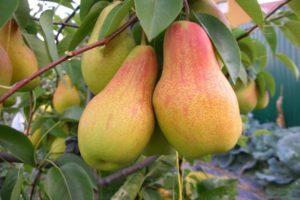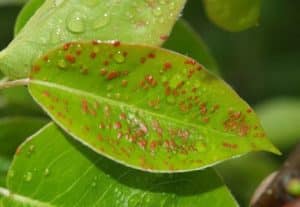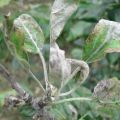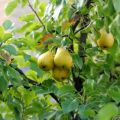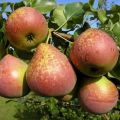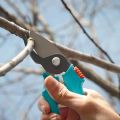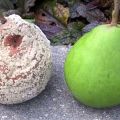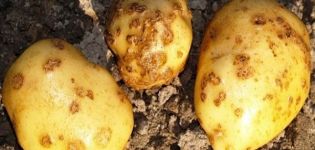Why do the leaves on a pear tree turn black, what to do and how to treat, how to deal with the disease
The leaves turn black on the pear - just right to grab your head. Yesterday the tree was pleasing with a green crown and an abundance of ovaries. And today it is charred. This problem arises for inexperienced gardeners who neglect the rules for keeping a tree in the garden. But competent gardeners are not immune to trouble. The plant can be infected with an infection brought in from a nearby untreated area. To save the tree and preserve the harvest, you should establish the exact cause of the blackening and immediately begin treatment.
Possible causes of leaf blackening and how to deal with them
Usually, troubles become apparent in the summer. In order to timely see the appearance of the first black leaves, you should regularly inspect the plant.
The reasons for the blackening and drying of the crown:
- disease;
- damage by pests;
- illiterate care.
It is important to start treatment in a timely manner, since in advanced cases you will have to remove the entire tree.
Bacterial infection
A dangerous disease is a bacterial burn. Pears are sick before the age of 10 years. The infection infects the tree through leaf stomata, bark wounds, or insect bites that have previously been visited by diseased trees.
To prevent serious consequences, the first signs of the disease should be determined:
- first, black uneven spots appear on the leaves;
- then the leaves turn completely black and curl;
- leaves fall off, and blackness passes to young shoots;
- the affected branches dry out, and the trunk turns out to be black.
If at the first sign you do not start treating the pear, then after 2-3 weeks you will have to cut it down. Worst of all, the infection will affect the rest of the trees in the garden.
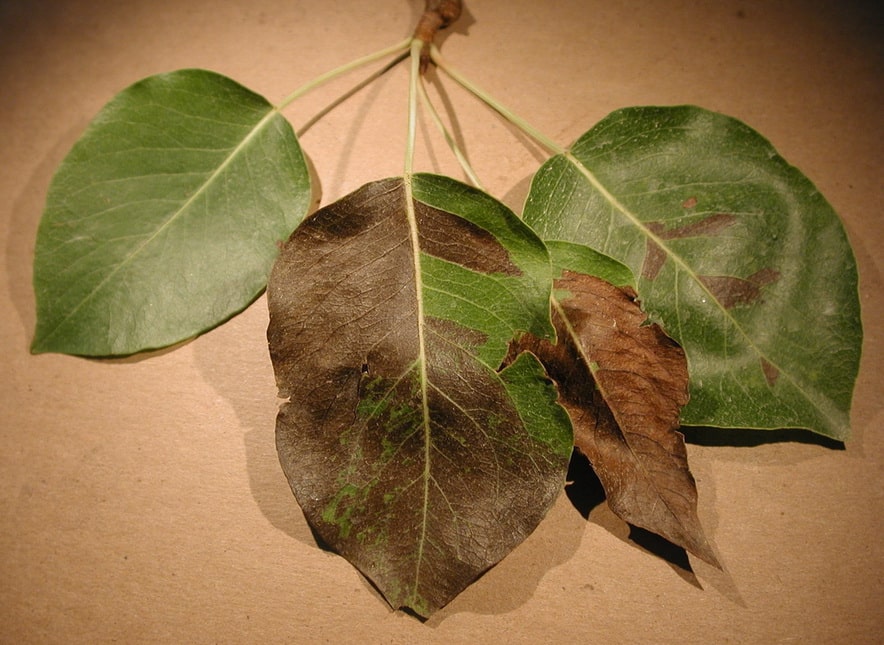
It is important to remember: at the first signs of the disease, it is required to cut off and burn the blackened leaves. Then cut out the affected shoots, spray the entire tree with a solution of a copper-containing preparation.
Scab
This is a fungal disease that affects young pears less than 10 years old. The reasons for its appearance are:
- damp weather;
- thickened plantings;
- genetic predisposition of the plant.
It is easy to determine the scab, it is enough to observe the plants. If on pear leaves:
- blurred spots appeared;
- and then turned dark;
- dots are visible on fruits or peduncles;
- the dots then grow into spots.
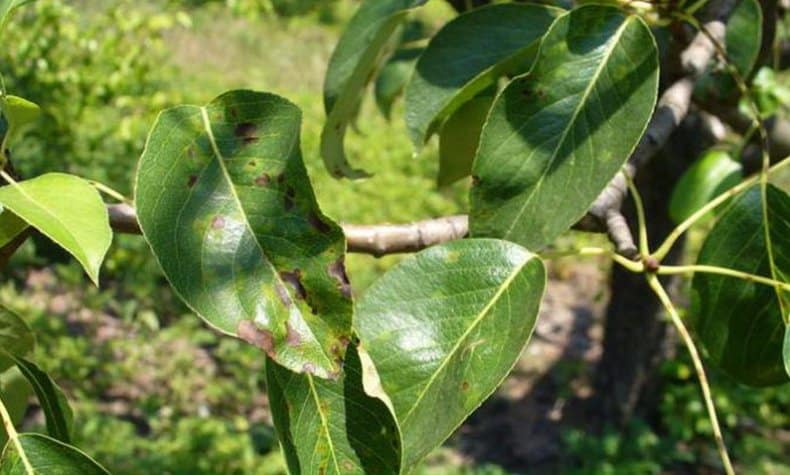
The scab is determined by a set of signs. It is quite difficult to fight the disease. Fallen leaves rot, but scab spores persist in the soil and can survive the winter. Next year, they will blow again on the pear with the wind.
When the first signs of fungus appear, the plant should be immediately sprayed with a copper-containing preparation.
Affected fruits can be eaten, but they will not be stored. In the fall, all leaves should be raked and burned, and the soil should be treated with a copper-containing preparation.
Medianitsa
When a pear is damaged by a copperhead, first the leaves are covered with black specks at the sites of the insect bite. The spots are soon scarred, but the tree is already affected: the leaves, trunk and twigs are covered with a sticky bloom, a product of the secretion of copperhead. In the process of the development of the disease, a sooty fungus grows on the sticky secretion, which passes to healthy parts of the plant. The tree is sick: the leaves dry and fall off, the bark stops letting in air, the fungus grows inside. After a while, in the absence of treatment, the pear withers and dies.
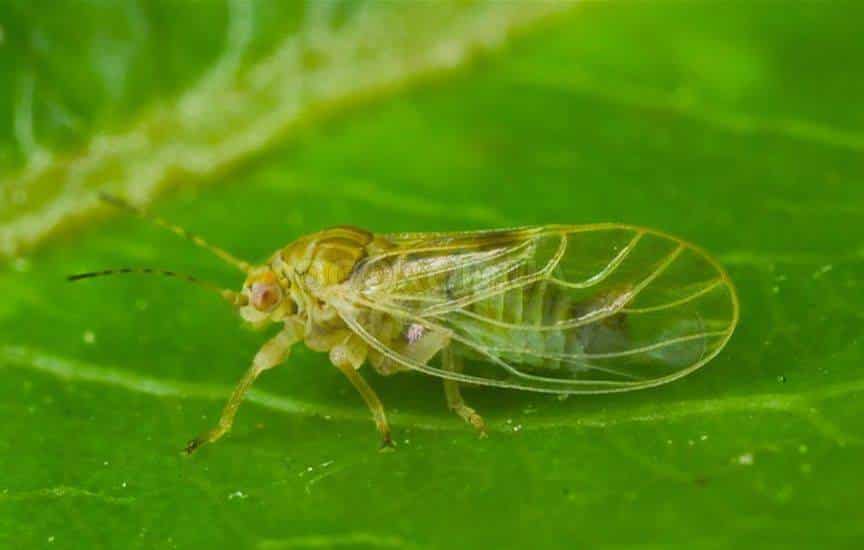
At the first signs of illness, it is required:
- spray the tree from the honeydew with a suitable insecticide;
- remove the affected leaves and burn.
In the fall, all garbage should be scooped up and burned. Then treat the crown and trunk circle with a copper-containing preparation. Repeat the treatment in spring. In addition, it is recommended to do preventive spraying against pests.
Care errors
Leaves and shoots often turn black and dry as a result of improper care. In this case, you should identify the cause of the disease and correct errors:
- Pear leaves wither, and then turn black and fall off during dry summers or significant dust emissions into the atmosphere. Unfortunately, the gardener cannot correct the ecological situation.
- The whole top of a young pear has dried up, which means that the tree is lacking calcium. It is recommended to urgently feed the tree with calcium nitrate (at the rate of application).
- The seedling has twisted and blackened shoots, it has stopped growing, which means that the pear has a lack of boron. In this case, it is sufficient to spray with boric acid solution. Subsequently, during routine feeding, it is recommended to apply fertilizers with the required amount of trace elements.
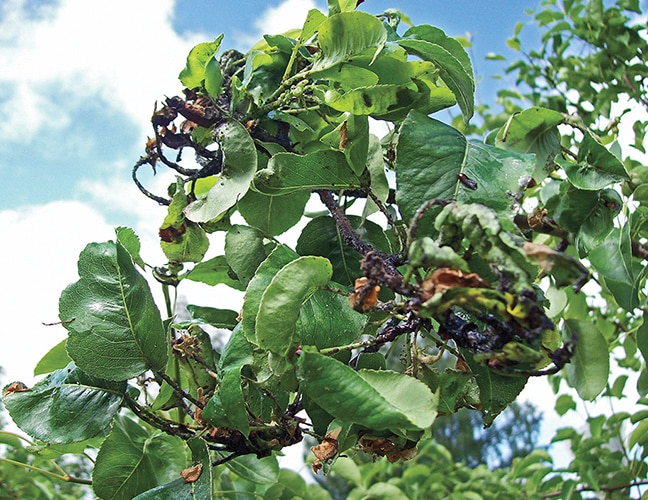
It is important to remember: a healthy tree will not blacken and dry out the foliage. And health can provide proper care: timely feeding, watering, spraying and pruning.
Pear leaf pests
Pests often cause blackening of pear leaves. They parasitize on the crown and cause premature wilting and drying out.
Medianitsa
The winged pest feeds on pear juice. As a result, the leaves turn black and fall off. The waste products of the suckers leave a sticky coating on the foliage and bark. It is a breeding ground for sooty fungus. Traps hung in the crowns of pears will help to reduce the pest population. To do this, fermented jam is diluted in a liter of water, poured into bottles with holes made. Traps are renewed once a week.

Pear gall mite
The gall mite pierces the leaves with its proboscis and sucks out the juice. But it is extremely difficult to notice it: the insect is small and almost does not manifest itself. The gardener simply notices that the leaf has turned black and dry. A pear deprived of leaves weakens and dies over time.
Fighting a tick is quite difficult. At the first symptoms of damage, two spraying with insecticides should be carried out with an interval of 14 days.
Aphid
There is hardly a garden free from this pest. The aphid itself is not very active. But the products of its vital functions have a sweet taste and attract ants. It is the latter who settle the aphids on the pear. Aphids stick to leaves, suck out juices and drain them. Subsequently, the leaves turn black, then dry out and become unsuitable for photosynthesis. As a result, the tree weakens and sheds the ovaries.
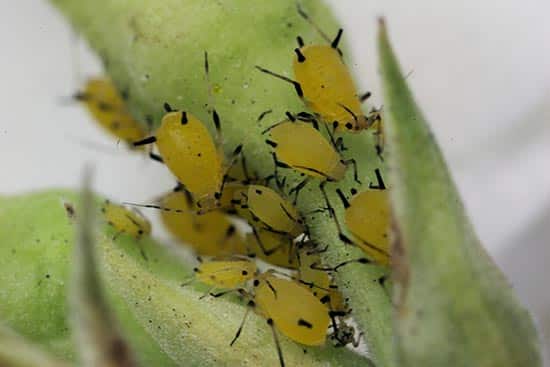
The danger of aphids is that insects carry infectious and fungal diseases. Pest control does not guarantee that the pear is not infected with fire blight or scab. To combat aphids, it is recommended to get rid of anthills.In the first half of April, the garden should be treated with insecticides. Timely weeding of pear tree trunks and removal of weeds will help to reduce the aphid population. Spraying with tobacco infusion with the addition of green soap will help protect the crown.
Prevention and treatment methods for trees
In order to protect the pear from blackening of the foliage, preventive measures should be taken:
- Apply top dressing in a timely manner: a healthy tree has strong immunity.
- Choose varieties and hybrids for planting that are resistant to bacterial burns and scab.
- Pull the weeds out in time.
- Perform spring treatment against ants.
- Hang sticky tapes among the trees. Inspect them daily and identify adhering pests. When a honeydew or gall mite appears, immediately treat with insecticides.
- Observe the distance when planting trees and shrubs in the garden.
- Timely carry out sanitary and formative pruning in the garden.
- To carry out spring and autumn preventive treatment with insecticides.
- Remove and burn off plant residues.
- Attract beneficial insects (ladybirds, ant lions) to the garden for pest control.
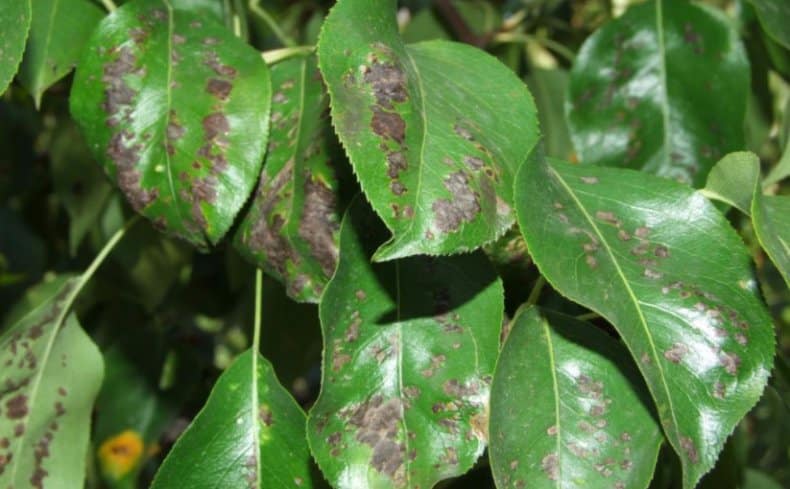
It is important to understand: it is easier to prevent the appearance of pests than to get rid of them later and treat the garden.
Folk remedies and recipes
There are folk methods for pest control:
- Old millet scattered around the anthill will make the pests leave their homes.
- Spraying with a urea solution along the near-stem circle in the fall will kill the wintering pests.
- Covering the trunk circle with dark-colored lutrasil in spring will prevent years of wintering copperheads.
- Quite good results are obtained by preventive fumigation with smoke during the opening of leaves in spring.
To prevent the invasion of pests, calendula, delphinium, yarrow, tobacco should be planted in the garden.
